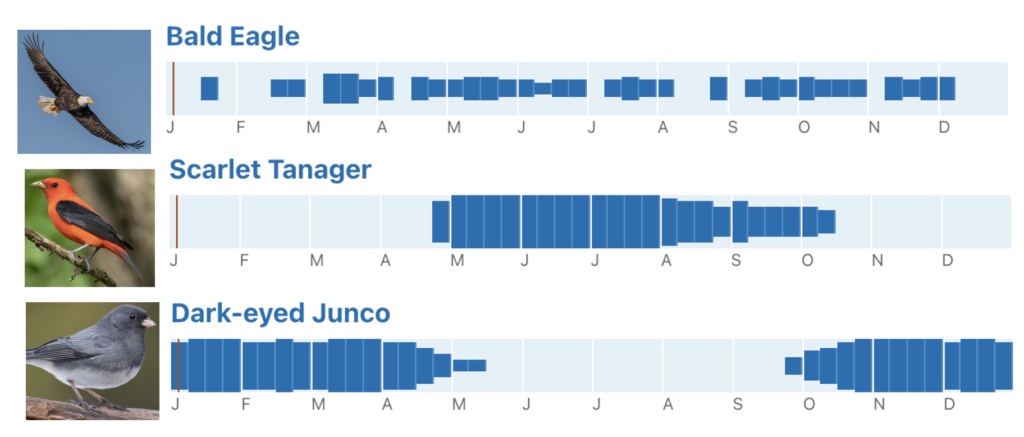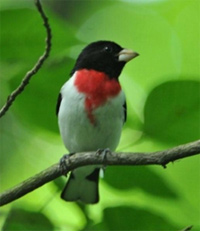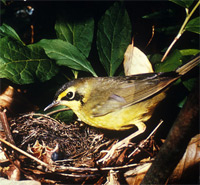Bird Counts
Birding is a great activity you can do while relaxing on a bench in one of our preserves or hiking along our trails. Even better is that you can record what birds you see and hear to help biologists identify which species are abundant and which have declining populations. Read further to learn how you can get involved!
eBird
eBird is an online checklist coordinated by the Cornell Laboratory of Ornithology and the National Audubon Society. You can download the app to your phone and upload your bird sightings – eBird also offers great tools on how to identify common bird species. All FoHVOS preserves with a trail are listed as an eBird “hotspot”, allowing hikers and birders to upload sightings to a single location. From the app, we can see what birds frequent Ted Stiles Preserve at Baldpate Mountain, and at what times of the year birders often see them!

© Birds of the World
For example Bald Eagles can be found at Baldpate throughout the year, but Scarlet Tanagers are only here during the summer breeding season. Meanwhile Dark-eyed Juncos hang around in New Jersey during the winter and migrate north to breed in Canada. Our partners at the Washington Crossing Audubon Society have contributed greatly to understanding bird diversity at our Mount Rose Preserve by using eBird – you can see their compiled lists here.
We encourage you to visit our trails and record what birds you see and hear. You don’t have to be an expert to recognize our most common birds! Add your list to the eBird website or app on your phone. For any questions email Senior Land Steward, Beth Craighead.
Great Backyard Bird Count

The Great Backyard Bird Count takes place every February on President’s Day weekend, Friday to Monday. This bird census that can be done anywhere by anyone! You can spend as little as 15 minutes standing in your backyard counting birds for least one out of the four days of the count.
This census is a great way to get involved with the ecological health of the Hopewell Valley and to find out how the birds are doing in your area. More instructions on how to participate can be found at https://www.birdcount.org/participate/.
To register for this year’s Backyard Bird Count, contact Senior Land Steward, Beth Craighead.
Christmas Bird Count

The Christmas Bird Count is sponsored by the National Audubon Society and takes place every year between mid-December and early January. Each year thousands of volunteers are outside counting birds at designated locations. Counts occur within a 15 mile wide diameter circle and are led by a designated compiler. The nearest one to us is the Princeton Circle which includes portions of Pennington and Hopewell. The results from every Christmas Bird count can be viewed here.
Bird counts help assess the health of bird populations and direct conservation efforts. From these these counts, scientists have discovered that most species have suffered profound population declines. In the last 50 years, 3 billion birds have disappeared from North America. The biggest driver of declines is habitat loss and degradation, especially in our forests and grasslands.
Over 50% of grassland birds species have disappeared and in our eastern forests, 170 million forest birds are gone. While some New Jersey species like the Field Sparrow, Eastern Whip-poor-will and Golden-winged warbler are in decline, others such as the Pileated Woodpecker and Blue-headed Vireo are increasing. Without the contribution of community birders, we would not know what species and habitats are in need of support.
Want to participate in the next Christmas Bird Count? Find the nearest count circle to you and sign up for the next count online. Contact FoHVOS Senior Land Steward Beth Craighead for questions about counts in Hopewell Valley.
| Common Birds in Decline (since 1967) | |
|---|---|
| Species | % decline |
| Northern Bobwhite | -82% |
| Evening Grosbeak | -78% |
| Eastern Meadowlark | -72% |
| Common Tern | -70% |
| Field Sparrow | -68% |
| Grasshopper Sparrow | -65% |
